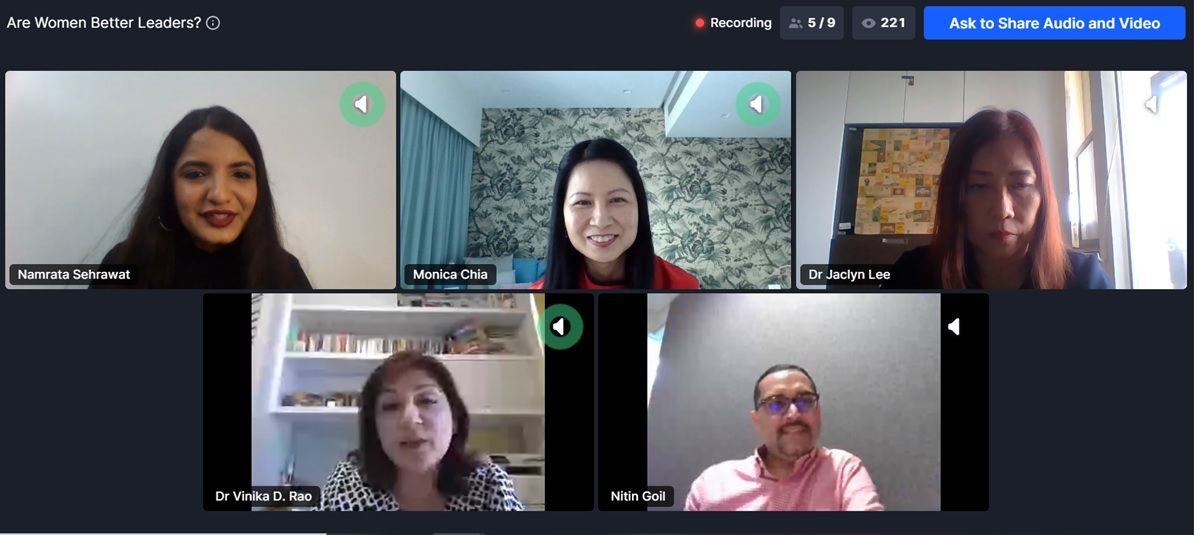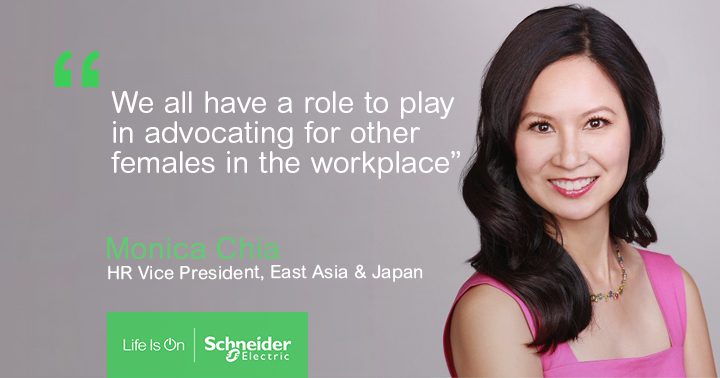On 24th September, I had the privilege to join as a panelist in a Panel Discussion at the Asian Women In Leadership Summit Singapore. In its 9th edition, this year’s summit was held on a virtual platform and brought together senior business leaders, policymakers, and entrepreneurs – men and women to discuss various initiatives and ideas to bridge the leadership gender diversity gap. Together with illustrious peers from the industry, we had an exchange on this topic and I would like to share a couple of thoughts upon reflecting on the insightful discussion that we had.
“Are women better leaders?”: majority say YES
It has been proven that a diverse organization would experience a higher level of innovation, performance, and better business results. Diversity extends beyond gender to nationalities, generations, etc. It enables us to see challenges differently and consider a broader solution for our employees, clients, and communities. This means that greater gender equity will bring about better business benefits.
According to research published by Harvard Business Review, women score higher than men in most leadership skills. In fact, while the differences were not huge, women scored at a statistically significantly higher level than men on the vast majority of leadership competencies they measured. The research analysed thousands of 360-degree reviews and found that women outscored men on 17 of the 19 capabilities that differentiate excellent leaders from average or poor ones.

In managing through the Covid-19 crisis, we have seen countries led by female political leaders (New Zealand, Taiwan, Germany, Norway, Finland, Iceland, Denmark) fared much better, suffering six times fewer deaths than countries with governments led by men.
Many of the adaptive capabilities that are more intuitive to women have taken center stage during this crisis period – collaboration, compassion, empathy, participative decision-making, creativity to name a few. Coincidentally, these characteristics are also highly valued by the Millennials and Gen Z – the future workforce – who place a high emphasis on human connection and community.
Within Schneider Electric, we have done an analysis after our Employee Feedback Survey, comparing randomly the results of 50 female people managers and 50 male counterparts, out of the total 233 people managers in East Asia Japan, we found that female leaders scored higher than male leaders across all four aspects being evaluated: Communication, Psychological Safety, Prioritization, and Empowerment.
It is important to emphasize that both women and men are equally capable of leading effectively, given the right competencies and experience gained. It is therefore important to achieve gender balance in the workplace and these studies give us an urge to act more boldly and rapidly to accelerate women to leadership roles because we haven’t done enough of this.

If yes, why do we still have challenges with women in leadership?
Firstly, let’s look at some external facts & figures:
- Only 4.9% of Fortune 500 CEOs and 2% of S&P 500 CEOs are women. And those numbers are declining globally.
- No country is on target to meet UN sustainable development goal #5 – gender equality by 2030.
- It will take 257 years to achieve gender parity according to the World Economic Forum.
Staggering statistics…
Internally at Schneider Electric, we have recruited 39% female at entry and reached 42% female representation at board level by Apr 2020. However, we only achieved 23% female representation in top positions globally.

Given all the business cases that we have built, and efforts spent to bridge the gender gap in leadership, why is it still challenging for more women to accelerate to leadership positions? There are 3 main reasons for this:
- Unconscious bias against women who lead: it has been a hardwired belief that leading is not for women. And while we are already in the 21st century, there are still certain stereotypes against women that hinder their acceleration. For example, in research published by HBR, “managers are nearly seven times more likely to tell their male employees that their communication style is too soft. Women, on the other hand, receive 2.5 times as much feedback related to their aggressive communication style.” Hidden bias creeps into hiring, rewards, and promotion decisions limiting women’s occupational prospects and constraints opportunities for career advancement. As a result, women had to be more competent and perform at a higher rate than men to gain access to high-status positions.
- The multiple roles that women are expected to fulfill: though the modern social context has changed the gender roles significantly, women are still expected to hold multiple roles than men. While there are more and more dual-career families, this expectation is especially prominent in Asia where familial values are deeply entrenched in our culture. Women are usually expected to perform 2 times the housework and three times the childcare. In my role as an HR Leader, I have encountered several occasions when I offered male colleagues roles that required relocation. In most of the cases, my colleagues would accept the relocation without considering asking their spouses, assuming their partners would quit their career and follow. Imagining the situation flips, will a female receive the same support from her partner?
- The fact that women are still holding themselves back due to self-limiting beliefs: having a long history of being contained by social and cultural norms, it is natural for women to develop an “invisible boundary” for themselves to be socially approved. In a professional context, this “invisible boundary” is holding women from being our best at work. One of these limiting self-beliefs is the failure to take credit for our achievements, choosing instead to keep silent and hope to be noticed or giving someone else credit for our work. Once I had a female colleague who was promoted for the stellar results that she had been delivering. When I approached to congratulate her, she said, “I got lucky”. And I replied, “You are really good at what you do. You earned the promotion”. While teamwork and collaboration played a role, her contributions had been instrumental to the success, yet she still refused to give herself the credit.
What have we been doing at Schneider Electric?
Solving gender equality issues requires an orchestrated effort.
As an organization that believes in equal opportunities for everyone everywhere, we Schneider Electric have been playing our role proactively in the equation.
We have achieved certain victories through our D&I Journey, notably with 42% female representation at board level by Apr 2020, via a diverse portfolio of our initiatives, such as:
- Our continual effort on Hidden Bias Education, reaching +22,000 employees, +4,000 managers, and 80% of our top leadership team;
- The launch of our Global Family Leave Policy, setting minimum global standards for parental leaves and care leave;
- The adaption of Flexible@Work, covering 89% of our employees, providing both male and female colleagues the access to telecommuting, flexible working hours, flexible holidays, and part-time working;
- The roll-out of the How Women Rise program, based on the book of the same name from Sally Helgesen and Marshall Goldsmith, helping our female colleague breaking their old “invisible boundary” via coaching and mentoring from senior successful female leaders in the company.
- Schneider Women Leaders Program, launched in 2019, after the Women in Leadership initiative (2012-2018) which resulted in the coaching of +700 women leaders from all entities.
 Yet there are areas that we can do more, on top of the global strategic pillars under our Gender Diversity agenda (Empowerment, Inclusive Practices, Inclusive Behaviours, Advocacy):
Yet there are areas that we can do more, on top of the global strategic pillars under our Gender Diversity agenda (Empowerment, Inclusive Practices, Inclusive Behaviours, Advocacy):
- Fostering an Inclusive culture via Inclusive behaviours, starting from leadership. The tone has to be set from the top. We will continue to encourage leaders to lead as an example and apply what they have learned through our Hidden Bias Education program into their daily routines.
- Driving more advocacy from both men and women via our strategic initiatives as HeForShe and How Women Rise, at the same time, holding our leaders accountable for mentoring and sponsoring our female talents.
- Building female leaders of the future: by advocating for female students and women in STEM, providing them with early professional exposure via Schneider Go Green, Internships, and mentorship with our leaders.
In East Asia Japan, our ambition is to reach 35% women at entry-level and 30% women in leadership by end of 2020. However, we strongly believe that the objective is not about the numbers, and the journey will not stop when we achieve the KPIs. It is more important for us to build a culture and an environment in which every one of our employees, including female colleagues, are empowered and included to be the best of themselves.
My advice to women on the gender parity journey
Be yourself, be confident, and know that you are bigger than who you think you are. Believe in your greatness.
We all have a role to play in advocating for other females in the workplace. Women need to be lifting women, put your passion into action to change the world, one woman at a time.
Join us to support more women in leadership here.
About The Author
 Monica Chia joined Schneider Electric more than a year ago as HR Vice President for East Asia Japan, leading our HR function across 14 countries with more than 3,000 employees. She is a results-oriented senior HR executive highly skilled in organization transformation, talent management, and culture-building whose broad HR experience ranging from building HR infrastructure, ramping up operations, integrating acquisitions to right-sizing operations as well as being well versed in all countries in the Asia Pacific.
Monica Chia joined Schneider Electric more than a year ago as HR Vice President for East Asia Japan, leading our HR function across 14 countries with more than 3,000 employees. She is a results-oriented senior HR executive highly skilled in organization transformation, talent management, and culture-building whose broad HR experience ranging from building HR infrastructure, ramping up operations, integrating acquisitions to right-sizing operations as well as being well versed in all countries in the Asia Pacific.
Join an inclusive team at Schneider Electric: www.se.com/careers
Follow Schneider Electric Careers on Social Media







